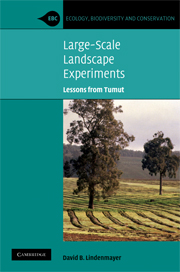Book contents
- Frontmatter
- Contents
- Preface
- Acknowledgements
- 1 The science of understanding landscape change: setting the scene for the Tumut Fragmentation Study
- 2 The theory: an overview of landscape change and habitat fragmentation
- 3 The field laboratory: the Tumut study area and the vertebrate animals it supports
- 4 Setting up the study: the design and implementation of the main cross-sectional study at Tumut
- 5 The core findings: the effects of landscape context on animals and plants
- 6 Patch use: how animals use patches of remnant eucalypt forest surrounded by pine
- 7 Theory against data: testing ecological theories and concepts
- 8 Testing PVA models with real data: melding demographic work with population modelling
- 9 Genes in the landscape: integrating genetic and demographic analyses
- 10 Refining and extending the research programme: additional studies at Tumut (and nearby) that build on the Fragmentation Study
- 11 Recommendations for plantation managers: implications for biodiversity and conservation in plantations
- 12 Lessons on running large-scale research studies: some insights from running the Tumut Fragmentation Study and directions for the future
- Appendix 1 List of collaborators/contributors to the Tumut Fragmentation Experiment
- Appendix 2 Detections of bird species in the Tumut Fragmentation Study classified by four broad classes of sites
- References
- Index
Preface
Published online by Cambridge University Press: 20 May 2010
- Frontmatter
- Contents
- Preface
- Acknowledgements
- 1 The science of understanding landscape change: setting the scene for the Tumut Fragmentation Study
- 2 The theory: an overview of landscape change and habitat fragmentation
- 3 The field laboratory: the Tumut study area and the vertebrate animals it supports
- 4 Setting up the study: the design and implementation of the main cross-sectional study at Tumut
- 5 The core findings: the effects of landscape context on animals and plants
- 6 Patch use: how animals use patches of remnant eucalypt forest surrounded by pine
- 7 Theory against data: testing ecological theories and concepts
- 8 Testing PVA models with real data: melding demographic work with population modelling
- 9 Genes in the landscape: integrating genetic and demographic analyses
- 10 Refining and extending the research programme: additional studies at Tumut (and nearby) that build on the Fragmentation Study
- 11 Recommendations for plantation managers: implications for biodiversity and conservation in plantations
- 12 Lessons on running large-scale research studies: some insights from running the Tumut Fragmentation Study and directions for the future
- Appendix 1 List of collaborators/contributors to the Tumut Fragmentation Experiment
- Appendix 2 Detections of bird species in the Tumut Fragmentation Study classified by four broad classes of sites
- References
- Index
Summary
The Tumut Fragmentation Study is a relatively rare beast in the world of ecological research – it's a large-scale, long-term ecological research programme that incorporates observational studies that have run for over a decade, experimental manipulations and integrated demographic and genetic research. The research programme has provided a platform for a range of simulation modelling studies. The Tumut Fragmentation Study has also served as a wonderful test bed for a broad range of ecological theory and a platform for modelling. And it all began with a glance out of a plane window.
In the early 1990s, I was flying to Melbourne from Canberra when I saw a fascinating landscape near the timber town of Tumut in southern New South Wales, south-eastern Australia. I saw vast areas of land in which the native forest had been cleared for pine plantation, and set in this plantation were numerous pockets of native forest that were now ‘islands in a sea of pines’. The exciting thing was that these ‘islands’ were not the unwanted parts of the landscape that you often find in pine plantations where, for example, native remnants are only on rocky hills. Nor were these remnants only representing riparian areas. They were, in fact, patches of forest of the same type as the nearby intact native forest.
And from this observation immediately sprang a series of questions: How does the biodiversity of these native remnants compare with the biodiversity of the intact native forest?
- Type
- Chapter
- Information
- Large-Scale Landscape ExperimentsLessons from Tumut, pp. xiii - xivPublisher: Cambridge University PressPrint publication year: 2009



